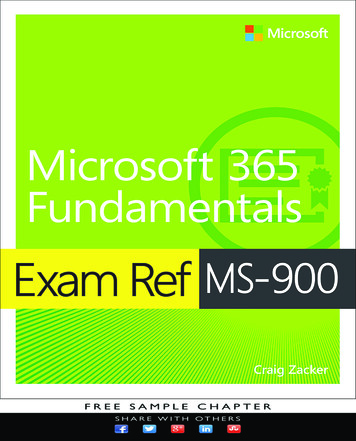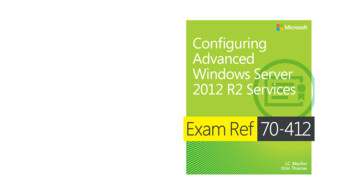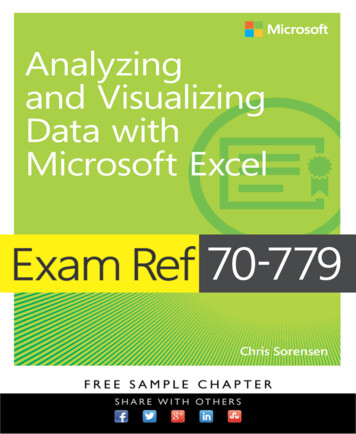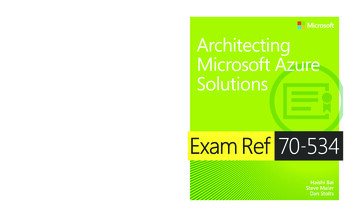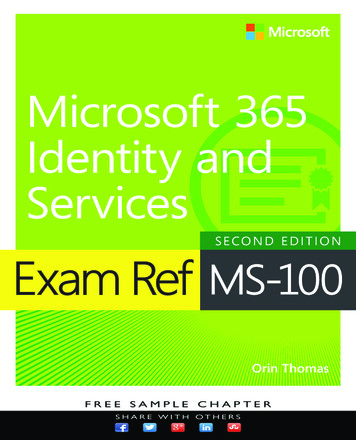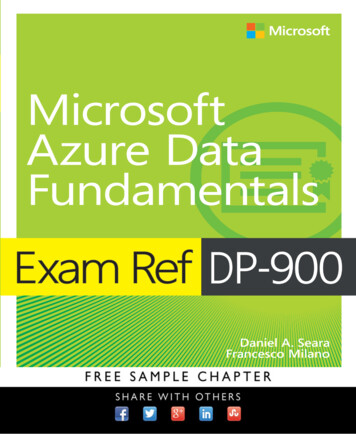
Transcription
Exam Ref DP-900Microsoft AzureData FundamentalsDaniel A. SearaFrancesco Milano
Exam Ref DP-900 Microsoft AzureData FundamentalsPublished with the authorization of Microsoft Corporation by:Pearson Education, Inc.COPYRIGHT 2021 BY LUCIENT DATA SA.CREDITSEDITOR-IN-CHIEFBrett BartowEXECUTIVE EDITORLoretta YatesAll rights reserved. This publication is protected by copyright, and permission mustbe obtained from the publisher prior to any prohibited reproduction, storage in aretrieval system, or transmission in any form or by any means, electronic, mechanical, photocopying, recording, or likewise. For information regarding permissions,request forms, and the appropriate contacts within the Pearson Education GlobalRights & Permissions Department, please visit www.pearson.com/permissionsDEVELOPMENT EDITORNo patent liability is assumed with respect to the use of the information containedherein. Although every precaution has been taken in the preparation of this book,the publisher and author assume no responsibility for errors or omissions. Noris any liability assumed for damages resulting from the use of the informationcontained herein.Sandra SchroederISBN-13: 978-0-13-725216-9ISBN-10: 0-13-725216-1Songlin QiuSPONSORING EDITORCharvi AroraMANAGING EDITORSENIOR PROJECT EDITORTracey CroomCOPY EDITORLiz WelchINDEXERLibrary of Congress Control Number: 2021931458Valerie Haynes cout FestaMicrosoft and the trademarks listed at http://www.microsoft.com on the “Trademarks” webpage are trademarks of the Microsoft group of companies. Lucient is atrademark of Lucient Data SA and the Lucient group of companies. All other marksare property of their respective owners.TECHNICAL EDITORWARNING AND DISCLAIMERCOVER DESIGNEREvery effort has been made to make this book as complete and as accurate as possible, but no warranty or fitness is implied. The information provided is on an “asis” basis. The author, the publisher, and Microsoft Corporation shall have neitherliability nor responsibility to any person or entity with respect to any loss or damages arising from the information contained in this book or from the use of theprograms accompanying it.SPECIAL SALESFor information about buying this title in bulk quantities, or for special sales opportunities (which may include electronic versions; custom cover designs; and contentparticular to your business, training goals, marketing focus, or branding interests),please contact our corporate sales department at corpsales@pearsoned.com or(800) 382-3419.For government sales inquiries, please contact governmentsales@pearsoned.com.For questions about sales outside the U.S., please contact intlcs@pearson.com.Herbert AlbertEDITORIAL ASSISTANTCindy TeetersTwist Creative, Seattle
Contents at a glanceIntroductionCHAPTER 1Describe core data conceptsCHAPTER 2Describe how to work with relational data on AzureCHAPTER 3Describe how to work with non-relationaldata on AzureCHAPTER 4xiii147135Describe an analytics workload on Azure203Index305
ContentsIntroductionxiiiOrganization of this book. . . . . . . . . . . . . . . . . . . . . . . . . . . . . . . . . . . . . . . . . . . . . . xiPreparing for the exam . . . . . . . . . . . . . . . . . . . . . . . . . . . . . . . . . . . . . . . . . . . . . . . . xiMicrosoft certifications . . . . . . . . . . . . . . . . . . . . . . . . . . . . . . . . . . . . . . . . . . . . . . . . xiiQuick access to online references. . . . . . . . . . . . . . . . . . . . . . . . . . . . . . . . . . . . . . . xiiErrata, updates & book support. . . . . . . . . . . . . . . . . . . . . . . . . . . . . . . . . . . . . . . xiiiStay in touch. . . . . . . . . . . . . . . . . . . . . . . . . . . . . . . . . . . . . . . . . . . . . . . . . . . . . . . . . xiiiChapter 1Describe core data concepts1Skill 1.1: Describe types of core data workloads. . . . . . . . . . . . . . . . . . . . . . . . . . . 1Describe streaming dataDescribe batch data310Describe the difference between batch and streaming data19Describe the characteristics of relational data20Skill 1.2: Describe data analytics core concepts . . . . . . . . . . . . . . . . . . . . . . . . . . 22Describe analytics techniques23Describe the concepts of ETL, ELT, and data processing28Describe data visualization and basic chart types36Chapter summary . . . . . . . . . . . . . . . . . . . . . . . . . . . . . . . . . . . . . . . . . . . . . . . . . . . . . 43Thought experiment. . . . . . . . . . . . . . . . . . . . . . . . . . . . . . . . . . . . . . . . . . . . . . . . . . 44Thought experiment answers . . . . . . . . . . . . . . . . . . . . . . . . . . . . . . . . . . . . . . . . . 44Chapter 2Describe how to work with relational data on Azure47Skill 2.1: Describe relational data workloads. . . . . . . . . . . . . . . . . . . . . . . . . . . . . 47Identify the right data offering for a relational workload48Describe relational data structures53v
Skill 2.2: Describe relational Azure data services. . . . . . . . . . . . . . . . . . . . . . . . . 58Describe and compare PaaS, IaaS, and SaaS delivery models60Describe Azure SQL Database63Describe Azure Synapse Analytics69Describe SQL Server on Azure Virtual Machine74Describe Azure Database for PostgreSQL, Azure Databasefor MariaDB, and Azure Database for MySQL79Describe Azure SQL Managed Instance83Skill 2.3: Identify basic management tasks for relational data . . . . . . . . . . . . 87Describe provisioning and deploying relational data services87Describe method for deployment includingARM templates and Azure Portal90Identify data security components(e.g., firewall, authentication)107Identify basic connectivity issues(e.g., accessing from on-premises, access with Azure VNets,access from internet, authentication, firewalls)112Identify query tools (e.g., Azure Data Studio,SQL Server Management Studio, sqlcmd utility, etc.)114Skill 2.4: Describe query techniques for data using SQL language. . . . . . . 122Compare DDL versus DML123Query relational data in PostgreSQL, MySQL,and Azure SQL Database126Chapter summary . . . . . . . . . . . . . . . . . . . . . . . . . . . . . . . . . . . . . . . . . . . . . . . . . . . . 131Thought experiment. . . . . . . . . . . . . . . . . . . . . . . . . . . . . . . . . . . . . . . . . . . . . . . . . . 132Thought experiment answers . . . . . . . . . . . . . . . . . . . . . . . . . . . . . . . . . . . . . . . . . 133Chapter 3Describe how to work with non-relationaldata on Azure135Skill 3.1: Describe non-relational data workloads . . . . . . . . . . . . . . . . . . . . . . . 135Describe the characteristics of non-relational dataviCONTENTS136Describe the types of non-relational and NoSQL data137Choose the correct data store142Determine when to use non-relational data143
Skill 3.2: Describe non-relational data offerings on Azure . . . . . . . . . . . . . . 143Identify Azure data services for non-relational workloads144Describe Azure Cosmos DB API144Describe Azure Storage155Describe Azure Table storage158Describe Azure Blob storage163Describe Azure File storage170Skill 3.3: Identify basic management tasks for non-relational data. . . . . . . 175Describe provisioning and deployment of non-relationaldata services175Describe method for deployment including the Azure portal,Azure Resource Manager templates, Azure PowerShell,and the Azure command-line interface (CLI)176Identify data security components(e.g., firewall, authentication, encryption)182Identify basic connectivity issues(e.g., accessing from on-premises, access with Azure VNets,access from internet, authentication, firewalls)190Identify management tools for non-relational data194Chapter summary . . . . . . . . . . . . . . . . . . . . . . . . . . . . . . . . . . . . . . . . . . . . . . . . . . . . 198Thought experiment. . . . . . . . . . . . . . . . . . . . . . . . . . . . . . . . . . . . . . . . . . . . . . . . . . 199Thought experiment answers . . . . . . . . . . . . . . . . . . . . . . . . . . . . . . . . . . . . . . . . . 201Chapter 4Describe an analytics workload on Azure203Skill 4.1: Describe analytics workloads. . . . . . . . . . . . . . . . . . . . . . . . . . . . . . . . . 203Skill 4.2: Describe the components of a modern data warehouse. . . . . . . 207Describe modern data warehousing architectureand workload207Describe Azure data services for modern data warehousingsuch as Azure Data Lake, Azure Synapse Analytics,Azure Databricks, and Azure HDInsight208CONTENTSvii
Skill 4.3: Describe data ingestion and processing on Azure. . . . . . . . . . . . . 232Describe the components of Azure Data Factory(e.g., pipeline, activities, etc.)233Describe data processing options(e.g., Azure HDInsight, Azure Databricks,Azure Synapse Analytics, Azure Data Factory)254Describe common practices for data loading276Skill 4.4: Describe data visualization in Microsoft Power BI. . . . . . . . . . . . . 278Describe the workflow in Power BI279Describe the role of interactive reports279Describe the role of dashboards294Describe the role of paginated reporting297Chapter summary . . . . . . . . . . . . . . . . . . . . . . . . . . . . . . . . . . . . . . . . . . . . . . . . . . . 299Thought experiment. . . . . . . . . . . . . . . . . . . . . . . . . . . . . . . . . . . . . . . . . . . . . . . . . 302Thought experiment answers . . . . . . . . . . . . . . . . . . . . . . . . . . . . . . . . . . . . . . . . 304IndexviiiCONTENTS305
AcknowledgmentsI would like to thank the following people, who helped me during the work on this book and inmy life, both professional and personal.First, thank you to my wife, Nilda Beatriz Díaz, for helping me daily be a better person and abetter professional, and for sharing with me the adventure of this life and this astounding work,all around the world.I would also like to thank all the members of our team at Lucient, who walk with me in thepath of knowledge and in the process of providing our customers with the services they deserve.For this particular book, one of them, Herbert Albert, was especially helpful, reviewing all ourtechnical content. Thanks again, my friend; I owe you another set of Argentinian-style pizzas.And finally, I would like to thank Lilach Ben-Gan, who makes my English writing more readable and clearer for you, the reader, and keeps our writing work flowing smoothly and on time.Daniel SearaWhile I am used to preparing and delivering live sessions, courses, and short articles, this wasmy first time writing a technical book. It is a very intensive and unique experience and, at thesame time, the perfect occasion to rearrange and extend my knowledge about the topics covered. But also, it is something I could not have achieved alone.I have to say a big thank-you to my wife and daughters for living many hours with a “ghost”in their house. It must not have been easy at times, but they heartfully managed to give me allthe time I needed.I would also like to thank everyone at Lucient, in particular the Italian team that took careof additional work to compensate for my months-long disappearance. Two special mentions:One is for Lilach Ben-Gan, who had the thankless task of improving my English and making itunderstandable, and the other one is for Herbert Albert, whose precious suggestions helpedimmensely in shaping the technical content to its best possible form.Finally, a big hug goes to my parents and parents-in-law for being our great helping hand. Ireally appreciate all your unrelenting efforts, and knowing you were there made the writing ofthis book more feasible.Francesco MilanoThe authors would also like to thank the team at Pearson who helped with the production of thisbook: Loretta Yates, Charvi Arora, Songlin Qiu, Liz Welch, Danielle Foster, and Tracey Croom.Acknowledgments ix
About the authorsDaniel A. Seara is an experienced software developer. He has more than 20 years’ experienceas a technical instructor, developer, and development consultant.Daniel has worked as a software consultant in a wide range of companies in Argentina,Spain, and Peru. He has been asked by Peruvian Microsoft Consulting Services to help severalcompanies in their migration path to .NET Framework development.Daniel was Argentina’s Microsoft Regional Director for 4 years and was the first nominatedGlobal Regional Director, a position he held for two years. He was also the manager of the Desarrollador Cinco Estrellas I (Five-Star Developer) program, one of the most successful trainingprojects in Latin America. Daniel held a Visual Basic MVP status for more than 10 years, as wellas a SharePoint Server MVP status from 2008 until 2014. Additionally, Daniel is the founder and“Dean” of Universidad .NET, the most visited Spanish language site on which to learn .NET.In 2005, he joined Lucient, the leading global company on the Microsoft Data Platform,where he has been working as a trainer, consultant, and mentor.Francesco Milano has been working with Microsoft technologies since 2000.Francesco specializes in the .NET Framework and SQL Server platform, and he focuses primarily on back-end development, integration solutions, relational model design, and implementation.Since 2013 Francesco has also been exploring emerging trends and technologies pertainingto the big data and advanced analytics world, consolidating his knowledge of products likeAzure HDInsight, Databricks, Azure Data Factory, and Azure Synapse Analytics.Francesco is a speaker at prominent Italian data platform conferences and workshops.In 2015, he joined Lucient, the leading global company on the Microsoft Data Platform,where he has been working as a trainer, consultant, and mentor.About the authors xi
IntroductionIn this connected era, it is important to determine how and when your data can be stored in thecloud. This book, both a reference and a tutorial, covers the different approaches to storing information in the Microsoft Azure environment. The book discusses and compares various storageoptions, helping you make better choices based on each particular need, and guides you throughthe steps to prepare, deploy, and secure the most appropriate storage environment.This book covers every major topic area found on the exam, but it does not cover everyexam question. Only the Microsoft exam team has access to the exam questions, and Microsoftregularly adds new questions to the exam, making it impossible to cover specific questions.You should consider this book a supplement to your relevant real-world experience and otherstudy materials. If you encounter a topic in this book that you do not feel completely comfortable with, use the “Need more review?” links you'll find in the text to find more informationand take the time to research and study the topic. Great information is available on MSDN, onTechNet, and in blogs and forums.Organization of this bookThis book is organized by the “Skills measured” list published for the exam. The “Skills measured” list is available for each exam on the Microsoft Learn website: http://aka.ms/examlist.Each chapter in this book corresponds to a major topic area in the list, and the technical tasksin each topic area determine a chapter’s organization. If an exam covers six major topic areas,for example, the book will contain six chapters.Preparing for the examMicrosoft certification exams are a great way to build your résumé and let the world knowabout your level of expertise. Certification exams validate your on-the-job experience andproduct knowledge. Although there is no substitute for on-the-job experience, preparationthrough study and hands-on practice can help you prepare for the exam. This book is notdesigned to teach you new skills.We recommend that you augment your exam preparation plan by using a combination ofavailable study materials and courses. For example, you might use the Exam Ref and anotherstudy guide for your ”at home” preparation and take a Microsoft Official Curriculum coursefor the classroom experience. Choose the combination that you think works best for you.Introduction xiii
Learn more about available classroom training and find free online courses and live eventsat http://microsoft.com/learn. Microsoft Official Practice Tests are available for many exams athttp://aka.ms/practicetests.Note that this Exam Ref is based on publicly available information about the exam and theauthors’ experience. To safeguard the integrity of the exam, authors do not have access tothe live exam.Microsoft certificationsMicrosoft certifications distinguish you by proving your command of a broad set of skills andexperience with current Microsoft products and technologies. The exams and correspondingcertifications are developed to validate your mastery of critical competencies as you designand develop, or implement and support, solutions with Microsoft products and technologiesboth on-premises and in the cloud. Certification brings a variety of benefits to the individualand to employers and organizations.MORE INFOALL MICROSOFT CERTIFICATIONSFor information about Microsoft certifications, including a full list of available certifications,go to http://www.microsoft.com/learn.Check back often to see what is new!Quick access to online referencesThroughout this book are addresses to webpages that the author has recommended you visitfor more information. Some of these links can be very long and painstaking to type, so we’veshortened them for you to make them easier to visit. We’ve also compiled them into a singlelist that readers of the print edition can refer to while they read.Download the list at als/downloads.The URLs are organized by chapter and heading. Every time you come across a URL in thebook, find the hyperlink in the list to go directly to the webpage.xiv Introduction
Errata, updates & book supportWe’ve made every effort to ensure the accuracy of this book and its companion content. Youcan access updates to this book—in the form of a list of submitted errata and their related 900AzureFundamentals/errataIf you discover an error that is not already listed, please submit it to us at the same page.For additional book support and information, please visit http://www.MicrosoftPressStore.com/Support.Please note that product support for Microsoft software and hardware is not offeredthrough the previous addresses. For help with Microsoft software or hardware, go tohttp://support.microsoft.com.Stay in touchLet’s keep the conversation going! We’re on Twitter: http://twitter.com/MicrosoftPress.Introduction xv
CHAPTER 2Describe how to work withrelational data on AzureRelational data is the most used storage since the last quarter of the past century. It is likely theconcept most students study at the very beginning of their careers. You will find concepts abouthow the data is stored, and the best ways to design them, in hundreds of books. No matter whatkind of information you want to preserve, a relational database is most likely a good option.NOTEOTHER OPTIONSAs you will read in the next chapter, a relational database is not the only option, and insome cases, relational data storage is not the best choice.Skills covered in this chapter: Skill 2.1: Describe relational data workloads Skill 2.2: Describe relational Azure data services Skill 2.3: Identify basic management tasks for relational data Skill 2.4: Describe query techniques for data using SQL languageSkill 2.1: Describe relational data workloadsRelational data storage is described as storing information based on a predefined structureof the information. Depending on the use of your data and your workload, you must selectthe technique that best matches your needs. Conceptually, in relational databases you try todefine things to represent the entities in the real world, like persons, companies, products,bills, and so on. We use the term “relational” to describe the relation in the data representing an entity, and not just because, for example, one bill could be related to a person and acustomer and was generated by a company. Moreover, it can have several products in thedetails, and all these elements are related. All this information must be stored in some way,and that is what we will cover here.47
This skill covers how to: Identify the right data offering for a relational workload Describe relational data structuresIdentify the right data offering for a relational workloadIf you analyze how your data has been managed in the past, usually you find one or moreapplications storing information in a centralized storage, probably a single database. Unlessdifferent business processes, or different areas, are involved with specific privacy or securityreasons, you will find a lot of applications storing all the information in just one database. However, during recent years, this has been changing. A lot of information is now stored in severalformats and places all around the world (in fact, all around the “cloud”).And this is an important matter to consider. Not only must you manage the data, but youalso must get information from several sources and, probably, adapt it to match the way yourbusiness uses the information.NOTEINFORMATION JOURNEYConsider the information traveling in an information pipeline, where each station can modify,extract, change, or refine information. That is the way information is managed these days.Online transaction processing (OLTP)This workload is what we typically get from business transactions, like bank transfers, onlineshopping, and cash machines, that are preserved in a data store. It is the repository for anytransaction related to the activities.In a health-care system, the information about every patient and each event—disease orsymptom, treatment, blood analysis, X-ray, and so forth—consists of activities for the system,and usually they are related in order to manage the information clearly.The concepts about OLTP are well known. The workload has been deeply analyzed, andmany rules have been defined to make OLTP work better. Probably the most important is theatomicity, consistency, isolation, durability (ACID) concept, which defines the properties ofdatabase transactions that must be completed to guarantee sustainable operations.EXAM TIPACID is a very important concept. In this book, you have the basic definitions, but otherresources elaborate on it. As a starting point, you can read the first article about thisconcept, “Principles of transaction-oriented database recovery,” at https://dl.acm.org/doi/10.1145/289.291.48Chapter 2Describe how to work with relational data on Azure
ATOMICITYThe name “atomicity” derives from the concept of an atom. It is something that must betogether. It is “all or nothing.”Consider this scenario: A patient requires treatment in the ER. The doctor needs somelaboratory checks for diagnostics purposes. The doctor performs some procedures to curethe diagnosed disease.When the procedures are completed, several pieces of information must be recorded:1.The patient’s symptoms2.The list of laboratory checks3.The result of those checks4.Each procedure, medical instrument, medication and dosage5.The closure: recommendations, future follow-up procedures, and so onAll this information and all the detailed costs of the procedures must be recorded as a singleunit. It is not useful, for example, to have the symptoms without the laboratory results.Ensuring that all the information is stored as one block, as an atom including all the parts atthe same time, is atomicity.CONSISTENCYThe information stored in a relational database usually has defined rules to ensure that all theinformation makes sense. Using the previous example, there is no sense in having the laboratory results without any indication of which patient they belong to, or the exact definition ofthe procedure.Ensuring that the information can be related in a specific way in the future is consistency.ISOLATIONIsolation ensures that other actors in the process do not access partial information.Two different areas in the hospital using the same information must access the same data.If someone at the ER office is entering the information at the same time another person is preparing the bill, it will not be good if the second person obtains the already stored laboratorychecks while the first person is still completing the registration of the procedures or drugs usedto treat the patient.During the update procedure, until the consistency has been maintained, the informationfor this specific transaction must be isolated from others.EXAM TIPThere is some fine-tuning of isolation, the so-called isolation levels. It is important to understand how they modify the behavior of the reads in a database environment. You can learnmore here: understanding-isolation-levels.Skill 2.1: Describe relational data workloadsChapter 249
DURABILITYDurability ensures that the information can be accessed later even after a system crash. Mostrelational database systems (RDBSs) use a mechanism to quickly store each step of an activityand then confirm all of them at the same time (known as a commit).After the commit succeeds, the information is secure. Of course, IT departments must dealwith external factors, but from a relational database point of view, the information is safe.Online analytical processing (OLAP)The OLAP workload, even when still a relational workload, was developed with data analysis inmind. You can think of it as looking to the past. The important element here is analyzing whathappened instead of registering what is going on.Using the previous example, OLAP will be used to evaluate how many patients the ERtreated in the last week, or month, or year; how many require follow-up; the average numberof laboratory procedures per patient; and so on.The most important difference between OLTP and OLAP is that OLAP is implemented forreading big amounts of data for data analysis, whereas OLTP is designed for many parallelwrite transactions.Another difference you can find in OLAP implementations is the fact that, usually, the OLAPdata has been restructured to facilitate the queries.Look at the partial entity-relationship diagram of products in the Adventure Works OLTPdatabase, shown in Figure 2-1, and compare it with the diagram for products in the AdventureWorks OLAP database, shown in Figure 2-2. The second one is more simplistic, but the tablescontain more columns. Moreover, if you look at the Product table in the OLAP version, you willsee that it has columns that are in other related tables in the OLTP model. That is because theOLAP data is flattened several times to accelerate the reads during the query process.NOTEDIFFERENT SCHEMASNotice that the entities in both schemas do not have exact matches; they are used just as asample to better illustrate OLAP database design and do not necessarily match the structured database design rules.The OLAP database uses a semantic model instead of a database schema. The semanticmodel redefines the information from a business point of view, rather than using a structuredpoint of view as the OLTP database schema does. This is because the business user, who is thefinal consumer for an OLAP implementation, knows the business entities but not the underlying data schema.The semantic model usually contains calculations already performed, time-oriented calculations, aggregation from different tables to make it easier to read the information, and in somecases, aggregation from different sources.50Chapter 2Describe how to work with relational data on Azure
FIGURE 2-1 OLTP database product relationshipsSkill 2.1: Describe relational data workloadsChapter 251
FIGURE 2-2 OLAP database product relationshipWhen you define an OLAP workload, you must decide which kind of semantic model to use,as shown in Table 2-1.TABLE 2-1 OLAP semantic models52OLAP ModelDescriptionTabularLike OLTP models, this model uses concepts such as tables, columns, and relationships.MultidimensionalA more traditional OLAP approach is used, based on cubes, dimensions, and measures.Chapter 2Describe how to work with relational data on Azure
Data warehousingUsing information from different sources, during a long period of time, implies keeping historical information in a secure, consistent way. Moreover, the storage solution must not burden theother workloads with the analytical process. This is where a data warehouse comes in.A data warehouse is the place to store historical and current information, preprocessed inways that facilitate the business analytical queries to get better results. In the implementationof a data warehouse, procedures are used to cleanse the data and make it consistent. Becausethe information can come from disparate sources, it must be preprocessed to facilitate betterresults from the business analytical queries.Several different tools and procedures are available to keep the information up-to-date ina data warehouse, but all can be defined as a three-part process: extract the information fromthe sources; store the results in the data warehouse; and transform, process, and ensure dataquality in some parts of the process.Sometimes, you prefer to transform the data before storing it in the data warehouse (theextract, transform, and load [ETL] process). In other circumstances, it could be more reliable,more secure, or simply cheaper to move all the information into the data warehouse and thenprocess it (the extract, load, and transform [ELT] process).NEED MORE REVIEW?TRANSFORMATION PROCESSESFor more information about the transformation processes, review Skill 1.2, “Describe dataanalytics core concepts,” in this book.Describe relational data structuresRelational data is about having the information stored according to specific structures andpredefined elements. This ensures the quality of the queries, the relationships, a
Data Fundamentals Published with the authorization of Microsoft Corporation by: . Preparing for the exam. xi Microsoft certifications . Describe Azure SQL Database 63 Describe Azure Synapse Analytics 69 Describe SQL Server on Azure Virtual Machine

